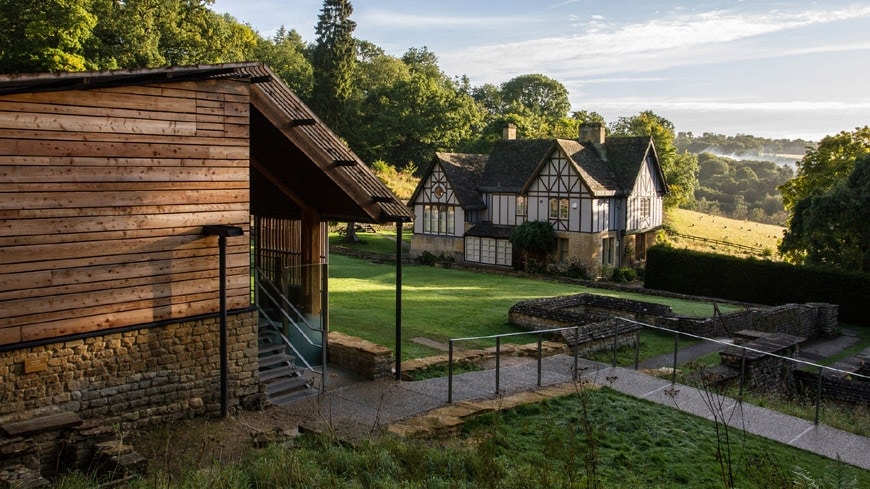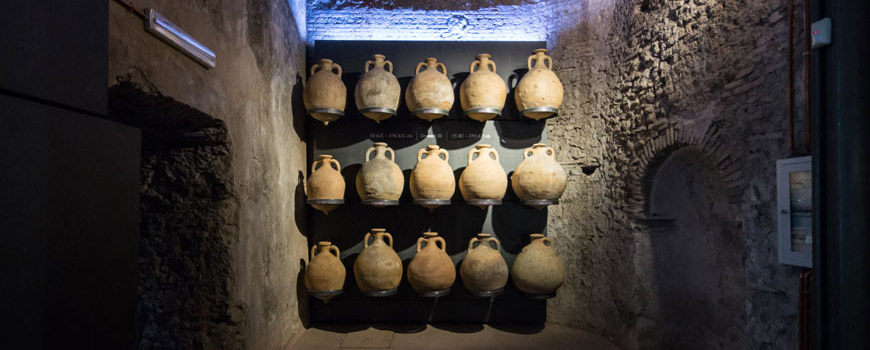Chedworth Roman Villa Archaeological Site – Feilden Clegg Bradley
Owner: National Trust
Feilden Clegg Bradley Studios
Tottenham Street, 20 London W1T 4RF
http://fcbstudios.com
Photos: John Dawson / FCBStudios / Integral Engineering / National Trust
Photo, copyright John Dowson
Chedworth Roman Villa archaeological site – Feilden Clegg Bradley Studios
“Whilst protecting the Roman remains at Chedworth Roman Villa the stunning buildings designed for the National Trust by Feilden Clegg Bradley Studios allow us to create a truly immersive experience and exceptional levels of access for our visitors.”
Janet Gough, General Manager, National Trust
“We wanted the Roman archaeology to take center stage.”
Feilden Clegg Bradley Studios
Introduction by Riccardo Bianchini, Inexhibit
This article is focused on the project by Feilden Clegg Bradley Studios for the Roman Villa archaeological site near the village of Chedworth, in Gloucestershire, a site of exceptional importance for the history of Roman Britain.
The remains of a large Roman villa, dating back to the 2nd century AD and progressively enlarged up to the 4th century, were accidentally discovered in 1864 by a gamekeeper and, since then, represent one of the most important archaeological sites in England, managed from 1924 by the National Trust. Not many know that not far from the villa there once was the second most important town in Britannia after London, Corinium Dobunnorum, now Cirencester. The Chedworth villa was probably a farm, lying in the fascinating landscape of the Cotswolds area.
This new building, refusing both the temptation to mimic the remains and to create an extremely self-imposing architecture at the expense of the archaeological set, is indeed capable of perfectly dealing both with the Roman excavations and with the noteworthy landscape surrounding them. This alchemy is archived with a skillful approach to the architectural forms and to the museum program as well as through an accurate selection of the most appropriate materials.
The final result is a fascinating cultural site where great archaeology, lively educational activities, a beautiful landscape, and excellent architecture all converge in one single point.
Top: the Roman villa in the Cotswolds landscape, copyright John Dowson
Bottom: The Roman Empire in the 4th century AD, copyright Inexhibit magazine
Project description by Feilden Clegg Bradley Studios
In brief
Chedworth Roman Villa is a Scheduled Ancient Monument set within an Area of Outstanding Natural Beauty in the heart of the Cotswolds. The National Trust appointed Feilden Clegg Bradley Studios as Architects and Lead Consultants to conserve the archaeology and improve the visitor experience of one of Britain’s largest Romano-British villas. The site includes over a mile of Roman walls, bathhouses, hypocausts, a water shrine and several mosaics thought to rival those in Pompeii.
Existing Victorian conservation sheds provided inadequate protection for the vulnerable archaeology. Plastic tents, erected as emergency cover from the weather, jarred with the rural surroundings. Access was also very outdated, making it extremely difficult for some visitors to view the mosaics.
Our new conservation shelter, following the line of the west range of the villa, now protects the most significant archaeological remains. A refurbished visitor reception building and a much-needed education center have also greatly improved the visitor experience.
Photo copyright John Dowson
Concept
The site’s rural setting, coupled with our unshakeable conviction that the Roman archaeology should remain the star of the show, inspired our formal and material approach to the new building.
We set out to create a building that provides a neutral, calm setting for the archaeology. Through rigorous detailed design, we worked hard to suppress distracting details – such as gutters and window frames – that might draw attention and represent a degree of visual “clutter”.
Top: Design sketches, copyright Feilden Clegg Bradley Studios
Bottom: photo copyright John Dowson
Context
Our masterplan showed that Victorian efforts at conservation on the site were outdated and that the early conservation shelters simply weren’t providing sufficient protection. The National Trust wished us take a fresh look at interpretation and to provide new opportunities for learning and enjoyment.
The brief emphasized that the new buildings should add a new layer to the extraordinary history of Chedworth Roman Villa, from the laying of the first stone in the 2nd century to its rediscovery in Victorian Britain in 1864.
Now our £2.2m project is complete, the Roman remains are better protected by a new shelter in the form of a lightweight, wrapped volume, intentionally neutral and abstract in appearance. Alongside the new conservation shelter, the old Victorian visitor center has been upgraded and works to the landscape have improved access and enhanced the setting of the villa.
Top: Siteplan, copyright Feilden Clegg Bradley Studios
Bottom: photo copyright John Dowson
Design approach
The new building sits lightly on the existing Roman foundations. The structure is assembled from a kit of parts and is held in place with optimally sized timber frames that didn’t require fixings into the Roman masonry of the villa. It holds its own weight and can be easily demounted or adapted as future interpretation and conservation practices change.
An external timber “wrap” is expressive, quite simply, of shelter. It was important to avoid any suggestion of reconstruction of the Roman villa, and the new building boldly celebrates the juxtaposition of new and old.
Visitors are now able to access far more of the site than before, allowing the public to see significant stretches of mosaics for the first time since they were originally discovered. Suspended walkways hang from the trusses, further enhancing the visitor experience by allowing people to walk only a few inches above the floor mosaics, echoing the footsteps of their Roman ancestors.
Top: photo copyright John Dowson
Bottom: photo copyright Integral Engineering & National Trust
Materials
Lime mortar, limestone and timber were the principal connections linking new and old, with concrete limited to only a few historically unimportant places on the site.
The new shelter eliminates the environmental effects that were previously affecting the Roman mosaics with a weatherproofed, black single-ply membrane, clad in larch battens. These battens were sourced by the National Trust and will weather to a color that harmonizes with the local stone. They add a gently uneven texture to the façade and sit sympathetically within the beautiful surrounding landscape.
We implemented sliding timber panels on glazed sections to control solar gain, with carefully angled battens preventing low-level sun from damaging the mosaics. This helps provide a technically stable environment for the villa’s archaeology while still enabling visitors to see clearly from both inside and outside the building. Mechanical dampers also maintain stable ventilation levels, allowing the building to “breathe” according to conservation needs.
Top: photo copyright John Dowson
Bottom: photo copyright National Trust
Sustainability
The glulam structure was made using European Larch grown in England, in order to limit the environmental impacts of transportation. We framed the secondary infill to external walls in European FSC-certified softwood, using plywood sheathing externally for structural rigidity.
All elements of the timber cladding, including the timber “wrap”, the sliding shutters, and weatherboarding are also of untreated European Larch, grown on the National Trust’s estate in its managed forest at Ashridge in Hertfordshire. It was selected as a UK-grown timber species with suitable natural resistance to decay without the aid of preservative treatments and an estimated lifespan of forty years.
The new education center re-uses the timber roof trusses and purlins of the two Victorian conservation shelters that we replaced. New, exposed elements forming part of this structure (notably, the columns) are of English Larch, which is stained to match the historic timber. Heating is generated through air source heat pump technology.
Top and bottom: photos copyright John Dowson.
copyright Inexhibit 2024 - ISSN: 2283-5474
















